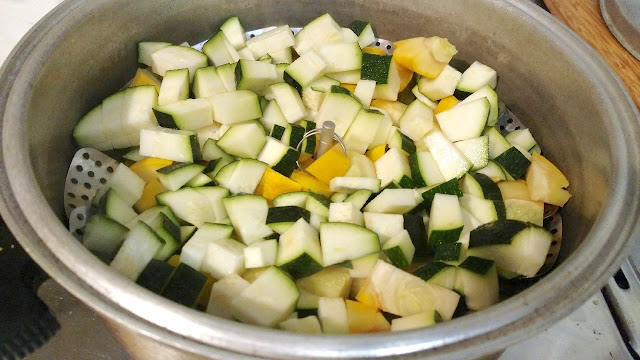
Recipe: Two-squash casserole uses mix of summer varieties

The yellow pattypan and green zucchini squashes are diced before steaming.
(Photos: Debbie Arrington)
|
Creamy summer squash casserole is an old Kentucky favorite. Usually, it’s made with baby crooknecks; peeled, boiled and mashed.
This variation uses a mix of summer squash, still plentiful in October. Even (somewhat) over-sized squash will work. Once puréed, big and little squash all cook the same.
The combination of green zucchini and yellow pattypan makes for an attractive side dish, too. All green or all yellow is pretty (and tasty), too.
Two-squash casserole
Makes 6 servings

Summer squash season is coming to an end, but there's
still time to find (or harvest) them for the casserole.
|
Ingredients:
2 pounds mixed summer squash (zucchini, pattypan, crookneck, etc.), chopped into 1-inch chunks
1 egg, beaten
¼ cup cream
1 tablespoon sugar
5 teaspoons cornstarch
½ cup (1 cube) butter, melted
½ cup onion, finely chopped
¼ cup Parmesan or Romano cheese, grated
Salt and pepper to taste

Instructions:
Grease a 2-quart casserole dish. Set aside.
Preheat oven to 350 degrees F.
Steam squash over simmering water until fork tender. In a food processor, purée squash until smooth.
In a mixing bowl, beat egg with cream. Mix together sugar and cornstarch; add to egg-cream mixture. Stir in melted butter and chopped onion. Fold in puréed squash. Season with salt and pepper.
Pour mixture into greased casserole dish. Sprinkle grated cheese over top.
Bake in a 350-degree oven for 40 minutes or until top is golden.
Serve warm.
Comments
0 comments have been posted.Sacramento Digs Gardening to your inbox.
Sites We Like
Garden Checklist for week of April 21
This week there’s plenty to keep gardeners busy. With no rain in the immediate forecast, remember to irrigate any new transplants.
* Weed, weed, weed! Get them before they flower and go to seed.
* April is the last chance to plant citrus trees such as dwarf orange, lemon and kumquat. These trees also look good in landscaping and provide fresh fruit in winter.
* Smell orange blossoms? Feed citrus trees with a low dose of balanced fertilizer (such as 10-10-10) during bloom to help set fruit. Keep an eye out for ants.
* Apply slow-release fertilizer to the lawn.
* Thoroughly clean debris from the bottom of outdoor ponds or fountains.
* Spring brings a flush of rapid growth, and that means your garden is really hungry. Feed shrubs and trees with a slow-release fertilizer. Or mulch with a 1-inch layer of compost.
* Azaleas and camellias looking a little yellow? If leaves are turning yellow between the veins, give them a boost with chelated iron.
* Trim dead flowers but not leaves from spring-flowering bulbs such as daffodils and tulips. Those leaves gather energy to create next year's flowers. Also, give the bulbs a fertilizer boost after bloom.
* Pinch chrysanthemums back to 12 inches for fall flowers. Cut old stems to the ground.
* Mulch around plants to conserve moisture and control weeds.
* From seed, plant beans, beets, cantaloupes, carrots, corn, cucumbers, melons, radishes and squash.
* Plant onion sets.
* In the flower garden, plant seeds for asters, cosmos, celosia, marigolds, salvia, sunflowers and zinnias.
* Transplant petunias, zinnias, geraniums and other summer bloomers.
* Plant perennials and dahlia tubers for summer bloom.
* Mid to late April is about the last chance to plant summer bulbs, such as gladiolus and tuberous begonias.
* Transplant lettuce seedlings. Choose varieties that mature quickly such as loose leaf.